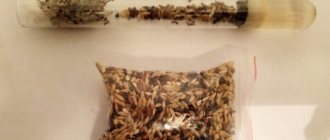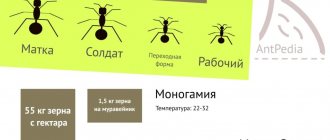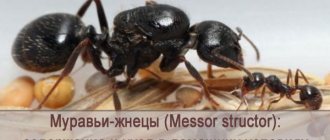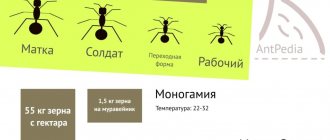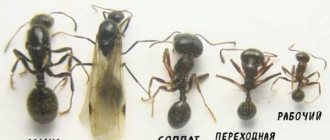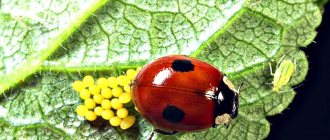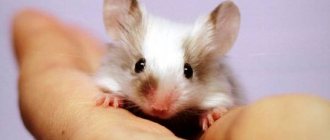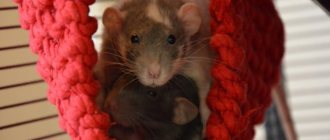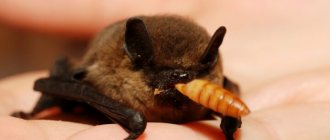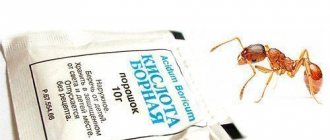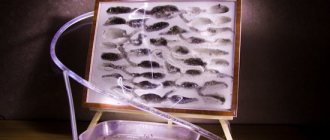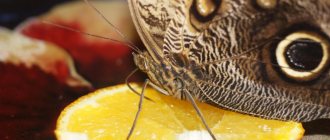Ants at home become the source of many troubles and troubles. People are faced with the problem of food spoilage and violation of cleanliness in their home territory. Parasites are clearly undesirable neighbors that should be eliminated quickly and effectively. It is known that the queen is considered the heart of all problems with small ants in an apartment and the fundamental link of the entire colony. Many poisons are aimed specifically at it, because after the death of the main production unit, the parasites are doomed. To understand the structure of the colony and the place of the queen in it, it is necessary to divide such insects into the following categories:
- Worker ants – life expectancy up to three years, main labor force;
- Males - participate exclusively in mating, and then die suddenly;
- The uterus is the longest-lived representative, which can maintain productivity and production ability for twenty years.
It becomes extremely clear that not only yellow ants in the apartment, but also all other species cannot exist without a queen. That is why it is necessary to consider in detail the information about such an interesting individual. Please note that many insecticides in the online store "Insects.NET" contribute to the rapid death of the entire colony of insects, due to the rapid spread of poison among representatives by contact. A great way to forget about pest infestations forever!
Development and reproduction
Responsible for the production of new individuals in the anthill is the uterus, or queen . She never leaves the nest, and worker ants take care of her and get food.
Reproduction
How do ants reproduce? Once a year, ants can reproduce, resulting in a large number of winged individuals - these are females and males ready to mate. The process occurs in these insects during “flight”. After mating, males usually die immediately. Those males who did not find or were unable to fertilize the female are either expelled from the anthill or killed by the worker ants themselves.
Fertilized females do not return to their anthill, but look for a place to create their own separate nest. There they lay the first eggs, which pupate after 2-3 weeks, and after 4-6 weeks the first workers emerge from them. After this, the females chew off their wings.
Before the worker ants appear, the female does not feed, but uses the contents of special fatty glands to provide for herself and the larvae.
With the appearance of ordinary insects, they are already engaged in searching and delivering food for the queen and larvae. From now on, the female ant carries out almost continuous laying of eggs, and under favorable environmental conditions she can do this all year round and during wintering too.
Types of development
The types of development of ants are very numerous. Ants are insects with a complete life cycle: egg, larva, pupa and adult.
The first stage of development of every ant is the egg. After the queen has laid eggs, they are kept not individually, but in small groups. At the end of the incubation period, larvae emerge from the eggs, similar to small worms. Only at this stage of development does the insect constantly feed and increase in size. Small larvae are kept in groups, just like eggs. Large ones - separately.
The next stage in the formation of an ant is pupation. Before this, the larva completely stops absorbing food, and also secretes a ball of waste, which can be seen at the end of the pupa in the form of a small black dot. There are species of ants whose larvae at this stage weave a cocoon for themselves.
The ant has a pupa, upon completion of its stay in which an adult, fully formed individual appears. It cannot break through the walls and leave the cocoon on its own, so the young insect is actively helped in this by its relatives. At first, such an ant is colorless, but after a few days its body takes on the correct shades for the species. From this moment on, the ant no longer grows.
The entire cycle from ant egg to adult takes about a month .
Structure and brain
The structure and brain of an ant are quite complex. Despite the huge variety of ant species in the world, they all have a similar structure. In addition, worker ants always do not have wings; females and males are winged.
The most common are forest and garden ants. Let us consider the structural features of the body of a female and male worker ant using the example of a worker individual. The insect's body is covered with a durable outer chitinous shell. It is clearly divided into three parts - the abdomen, the middle part and the head. The latter may, depending on the species and type of ant, have a different structure.
On the head are the eyes, which consist of a large number of small lenses. However, they can only recognize the fact of movement, but not objects. Also, in addition, the ant may have small additional eyes that determine the degree of illumination. How do ants communicate? There are antennae on the head that are designed to detect smells, air currents, vibrations, and communicate through touch.
Some ants have a sting at the end of their abdomen, which is used for hunting or protection.
The limbs of the insect (3 on each side of the body) consist of three parts. At the ends there are special gripping claws, thanks to which the ant can easily climb vertical surfaces.
Did you know that ants have been living in symbiosis with insects such as aphids for hundreds of years? Aphids feed the ants sweet syrup, and they, in turn, protect their “cash cows”. Read all about aphids on our website.
Sex of ants
The mechanism of sex determination in ants is designed in such a way that females and working insects grow from fertilized eggs, and males from unfertilized eggs.
The thing is that the female makes only one flight during her life in nature, during which she is fertilized and stores seminal fluid for the entire period of existence. She subsequently uses it to fertilize the eggs during their passage through the genital tract.
However, not all eggs are fertilized. From those that did not receive their portion of the seed, males are subsequently produced that have only one set of chromosomes - their mother's. Fertilized eggs produce either females or soldiers - this depends on the care and nutrition of the larva.
Lifespan
The lifespan of an ant usually depends on its role in the anthill.
Worker ants typically live about 3-5 years , with smaller individuals living slightly longer than larger ones. In addition, lifespan depends on their employment in the anthill. Thus, the individuals who are busy caring for the queen and ant larvae live the least, and those who perform internal work in the nest live the longest.
The lifespan of males is short, usually 2-3 weeks. They are called upon to perform the main function - to fertilize the female, after which the males either die immediately or are killed by their fellows when returning to the anthill.
REFERENCE! The longest lifespan is the queen, which can live up to 20 years , but a maximum lifespan of 28 years has been recorded.
Ants live in an anthill and have a clearly defined hierarchy. The queen is the main one in the nest; she is a former fertilized female, who then bit off her wings. Their lifespan is up to 20 years . Males live for approximately 2 weeks, during which they must find and fertilize a female.
Workers make up the bulk of the population of the anthill, and live, depending on their occupation, from 3 to 5 years. In addition, ants have natural enemies that can significantly shorten their lifespan.
So, ants are insects with a full development cycle, from egg to adult , they have a rather complex brain structure and perform a specific role in nature.
By the way, ants have many enemies in nature. Hedgehogs and birds, lizards and other reptiles can deal with a large number of individuals. On our website you will find information about such enemies of ants as shrews and moles. Read detailed articles about these animals.
Who is the queen ant?
When all the working individuals of the anthill are destroyed, the queen ant is able to restore the size of the colony in a couple of weeks, as a result of which there will be even more insects.
The queen is the progenitor of the colony; she is the king of the ants, or rather the queen, who does nothing but reproduce new inhabitants of the anthill.
To identify it, you need to know what the ant queen looks like; a photo will help you understand how it differs from other individuals.
Signs that this is a queen ant are as follows:
- The length of the body is up to 5 millimeters, it is twice as large as the other inhabitants of the anthill;
- The chitinous shell is colored darker than the rest;
- The abdomen is round, dark;
- The uterus moves little and looks massive.
On average, a queen ant lays 500,000 eggs. She feeds on what worker ants bring, but prefers food rich in proteins, which is necessary to give strength.
When the queen dies, the ants immediately find a new queen.
Photo
Next you will see a photo of a female ant:
How to detect a nest in the house
To eliminate pests, you should find a nest with a queen for further destruction. This is quite difficult to do. To detect a chamber with a uterus you need:
- view the movement of insects in the room to find all entrances and exits;
- trace all the passages of the anthill, since it happens that the anthill itself is not in the house itself.
Look where the insects take their food. Finding the queen may require removing all flooring and trim. Move furniture if necessary.
Why do ants die in an ant farm?
Although ants are very easy to care for, there are a number of diseases that the insects are susceptible to.
Why do ants die in an ant farm:
- Poisoning
- Incorrectly selected diet
- Parasites and diseases
- Disturbance of the microclimate in the formicarium
- Queen Death and Molds
Most often, insects suffer from fungal diseases, as well as parasites. The main signs of infection are high insect mortality and strange behavior. Often such insects walk in circles or crawl, freezing in one place. Ants die in whole groups.
Ants
How to catch
If you want to breed insects, you need to catch the queen. For this purpose, prepare a glass flask with cotton wool soaked in sweet water. You can wait for the queen purposefully when the flight takes place for the purpose of fertilization.
To breed insects, you first need to catch the queen
Queens without wings are better suited for incubation. This means that the insect has already been fertilized and is looking for a place to live. You should catch the female carefully, pushing the queen into the flask with the help of a thin twig. After a few days of settling in the incubator, the process of laying eggs will begin.
How does fertilization occur in house ants?
Ants prefer to establish a colony in protected places. All insects divide their housing into several chambers:
- food warehouse;
- ovipositor chambers;
- Queen's room.
From this video you will learn how to catch a queen ant:
More often, the anthill is located under the floor covering, as well as in the space under the baseboards. When the house is rarely cleaned, the insect takes up space behind the furniture. House ants do not reproduce at will. A uterus is required. It is its destruction that leads to the death of the entire anthill.
Stages of ant development: from egg to adult
An ant is an insect with all the stages of transformation inherent in it:
- Egg.
- Larval form.
- Pupation.
- Adult ant.
The queen lays eggs in groups of several dozen eggs. When the incubation period expires, a new form will be born - larvae. They look like small worms and only at this stage they absorb food around the clock and increase in mass and size. Small larvae lead a group existence, while large ones live separately.
The next stage of transformation is the formation of a pupa. Before modification, the larva does not eat and excretes excrement in the form of a ball (they are then located at the end of the pupa). After the time spent in the pupa has expired, a full-fledged adult ant emerges from it. But he himself cannot leave the solid walls of the cocoon; his fellow tribesmen help him get out. The newborn has a colorless body, which becomes the color characteristic of this species only after a few days. From the moment the young insect acquires its specific color, it stops growing. All stages of transformation take about a month.
Lifespan
The lifespan of an ant is determined by its gender and position in the family:
- males live for several weeks;
- working individuals - from several months to 3 (less often 5) years;
- the queen can live 15–20 years (a record of 28 years was recorded for a queen living in laboratory conditions).
Life expectancy is affected by living conditions, weather conditions, and the activity of natural enemies. Under natural conditions, the anthill population is renewed almost completely throughout the year (with the exception of the queen).
Reproduction
The honorable responsibility to increase the size of the colony rests with the queen . She is royalty and does nothing but lay eggs. She is protected, guarded, and some species even chew food for her.
How to become a queen? During summer (mating season), certain females and males acquire wings and fly out of the anthill to mate. The female is fertilized once; she will spend this seminal fluid throughout her life . Males die either after an act of love, or they are destroyed by their relatives themselves as unnecessary.
After fertilization, the female looks for a suitable place for the first egg laying. If everything goes well (she will not die, will not become a victim of bird hunting, and will be able to make a full clutch), then “Vivat Queen!”, the foundation of the future underground ant kingdom is ready. After 14-20 days, the egg clutch will pupate, and after another 25-40 the first ants will appear. This is a working group. He will begin to build and expand the anthill, store food and care for the next generation of ants. The female chews off her wings and from now on is only engaged in reproducing new members of the colony.
Until the first population of worker ants appears, the queen does not eat anything; she feeds the larvae with the contents of her fatty glands, from which she feeds herself.
